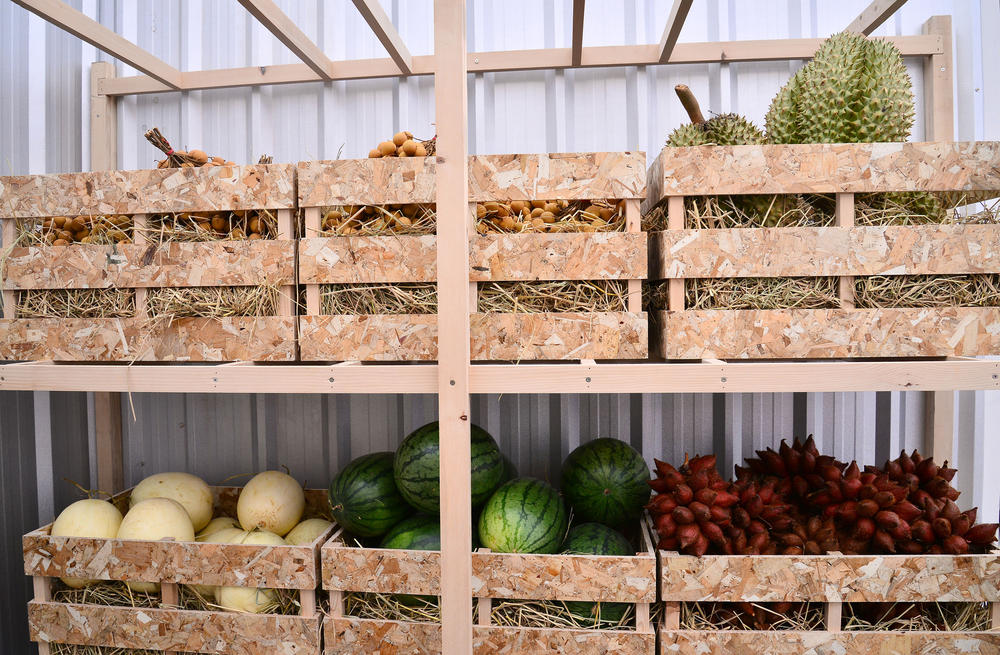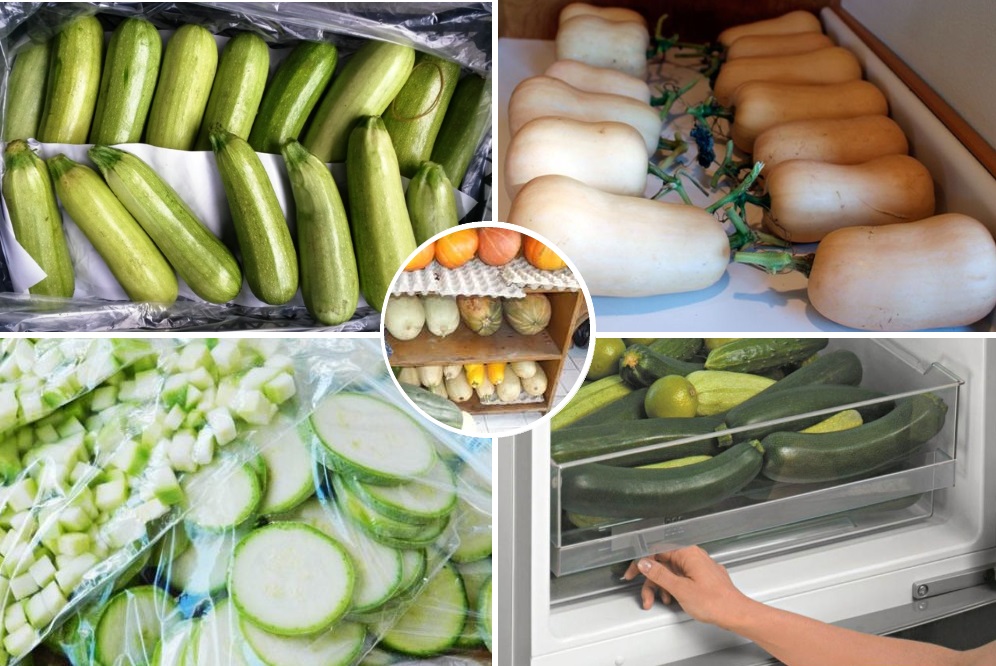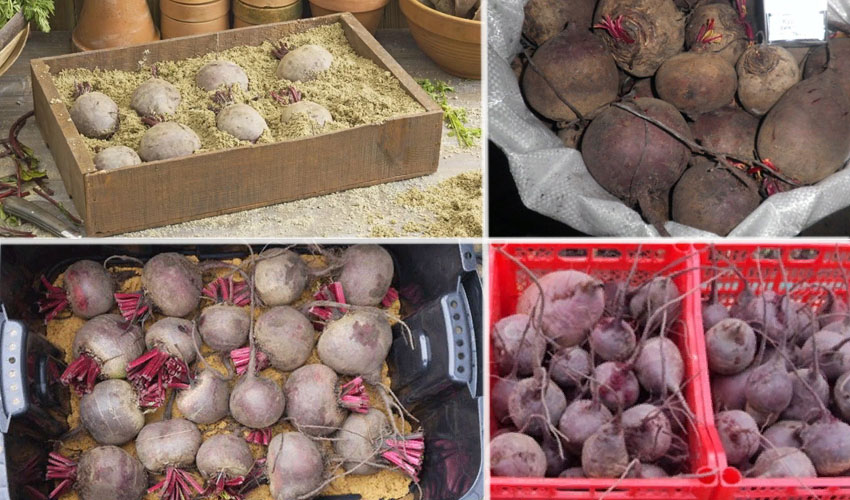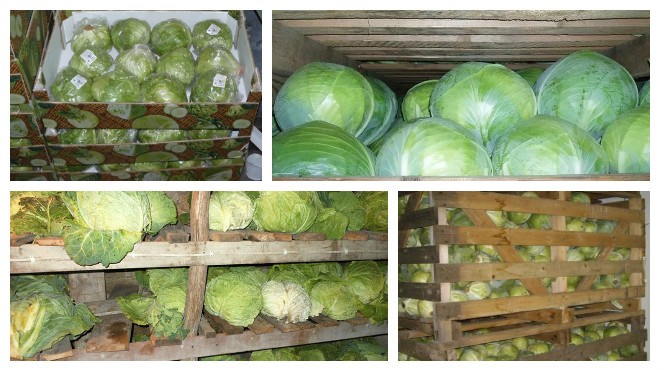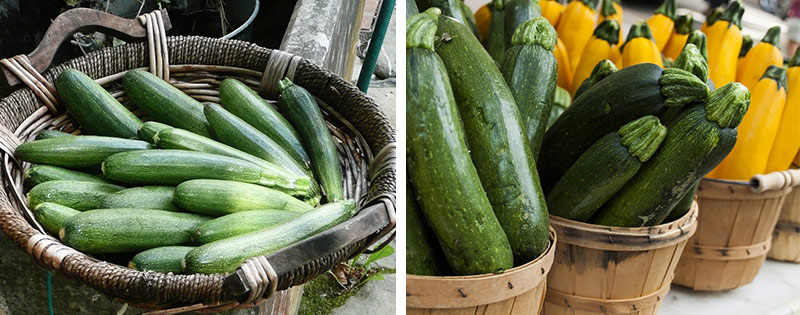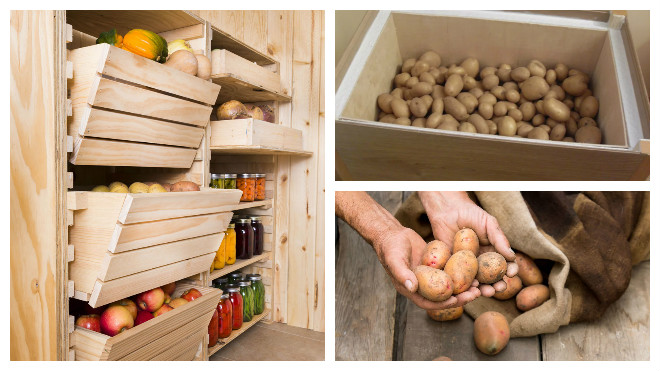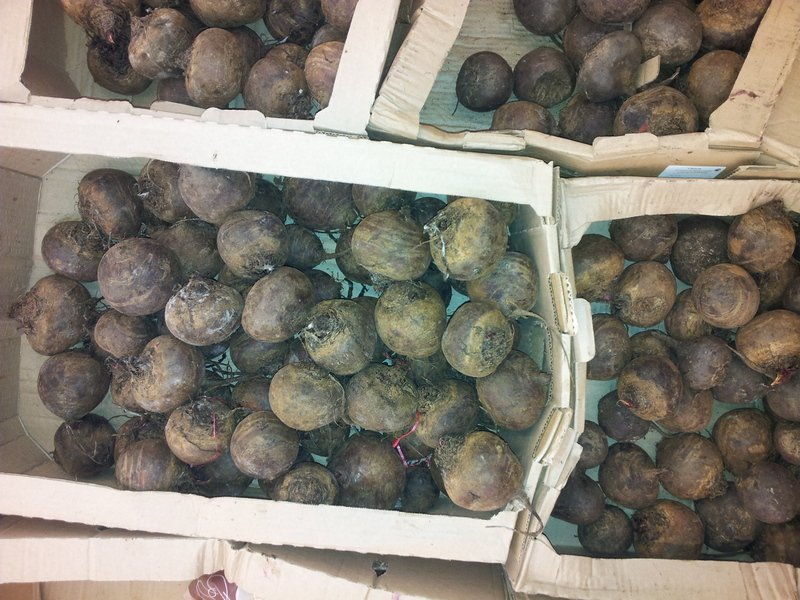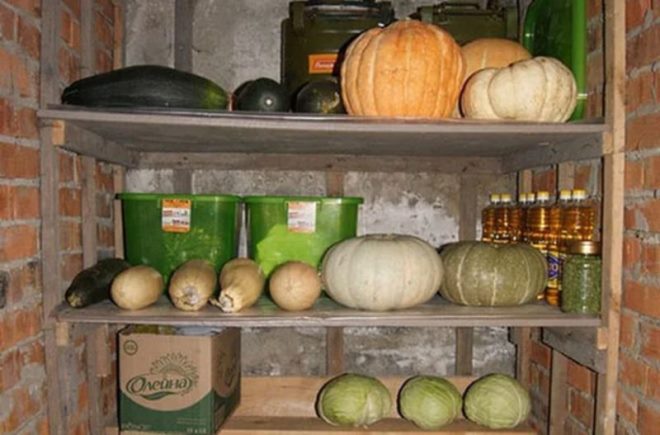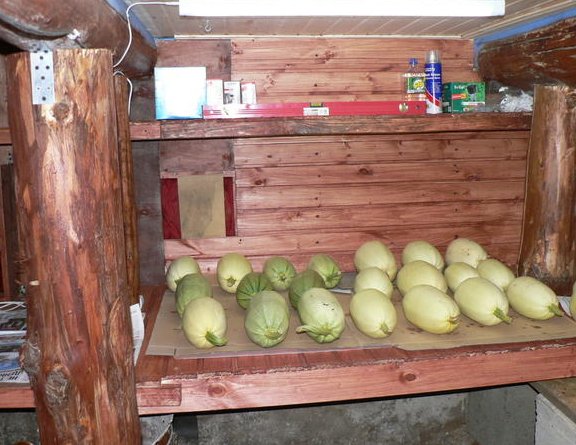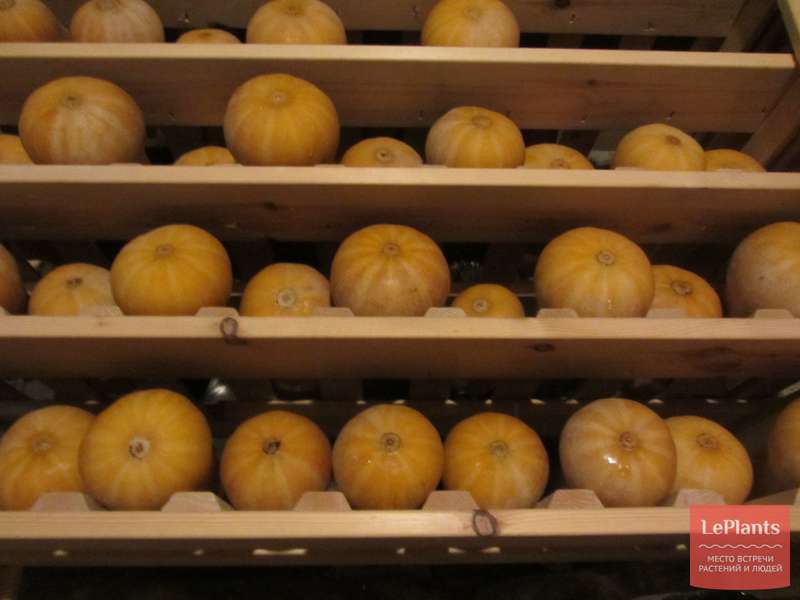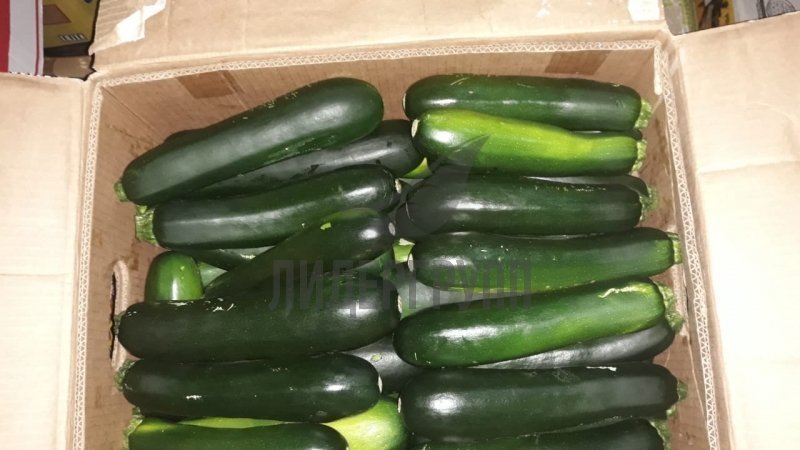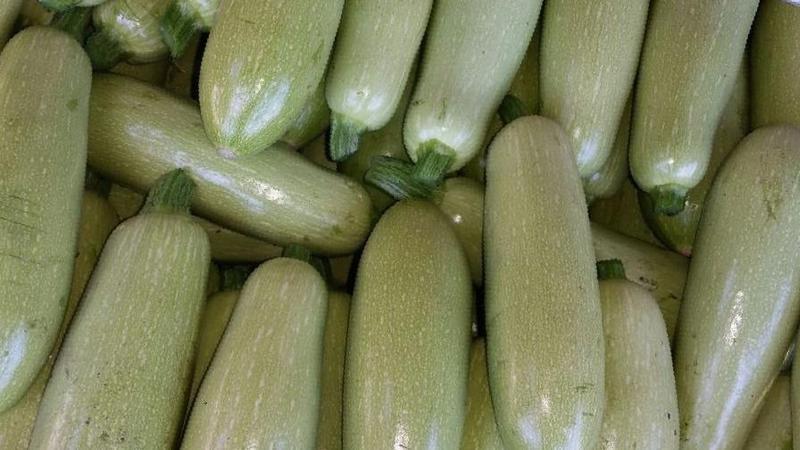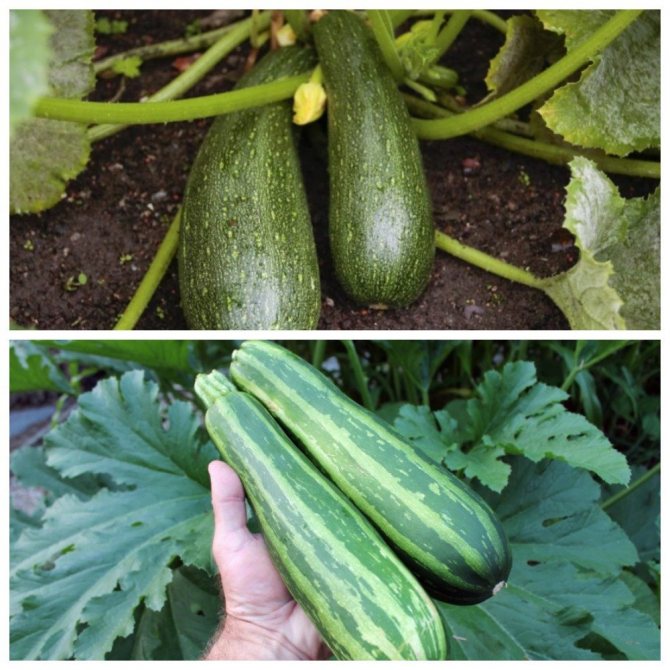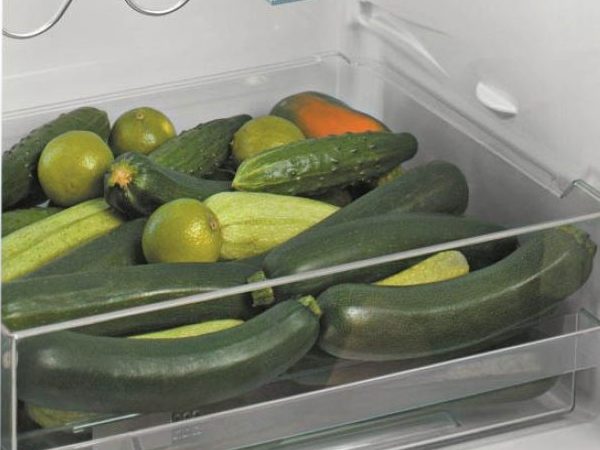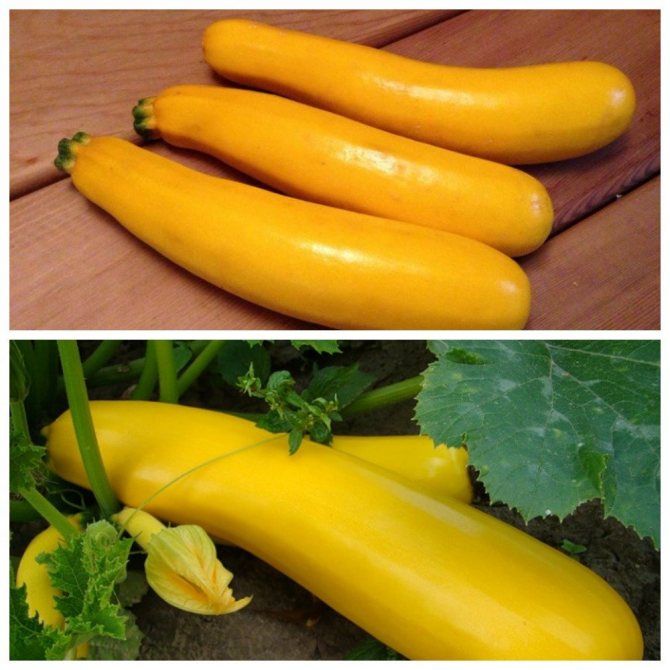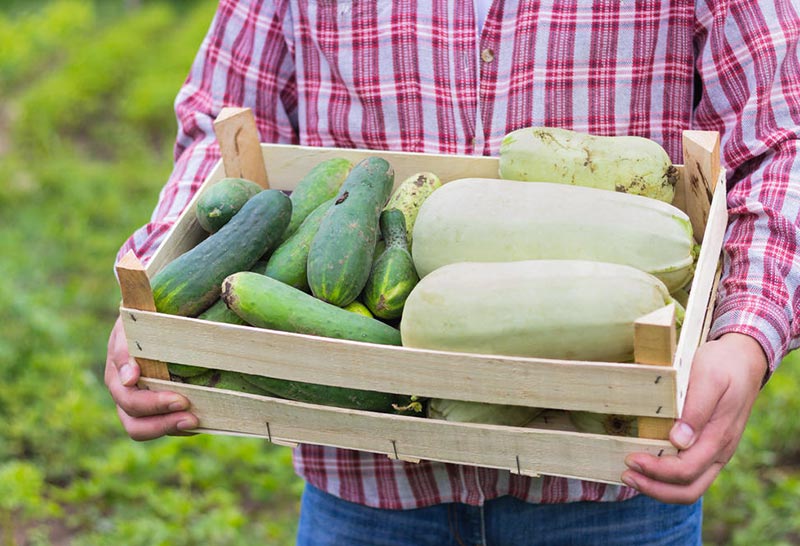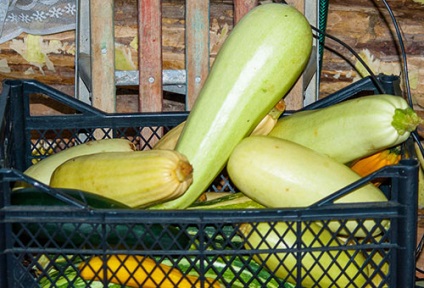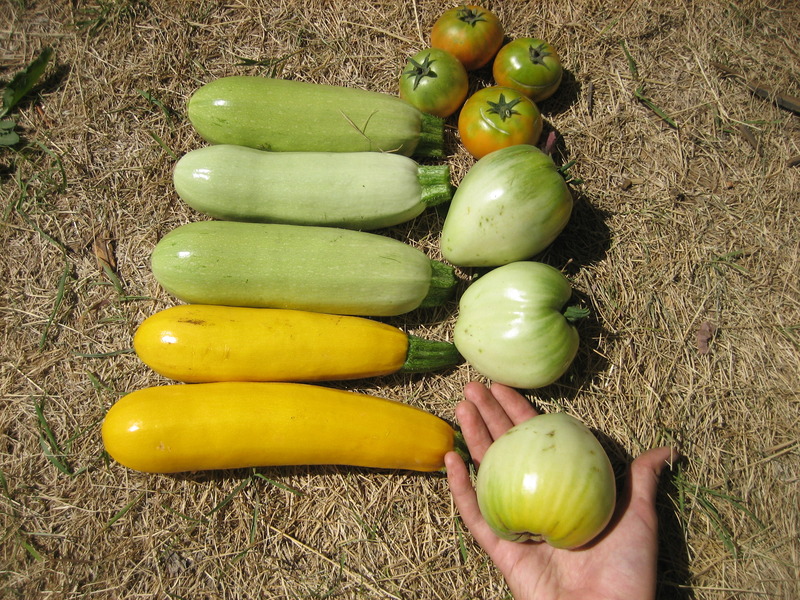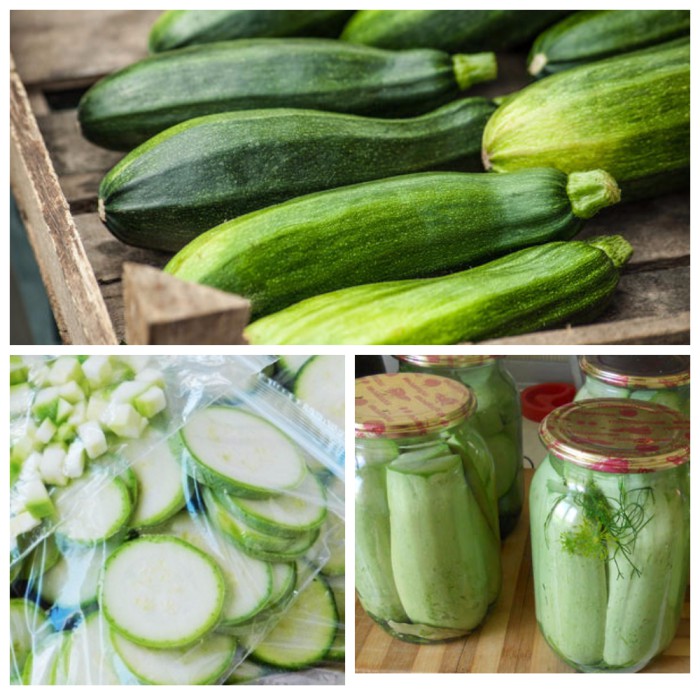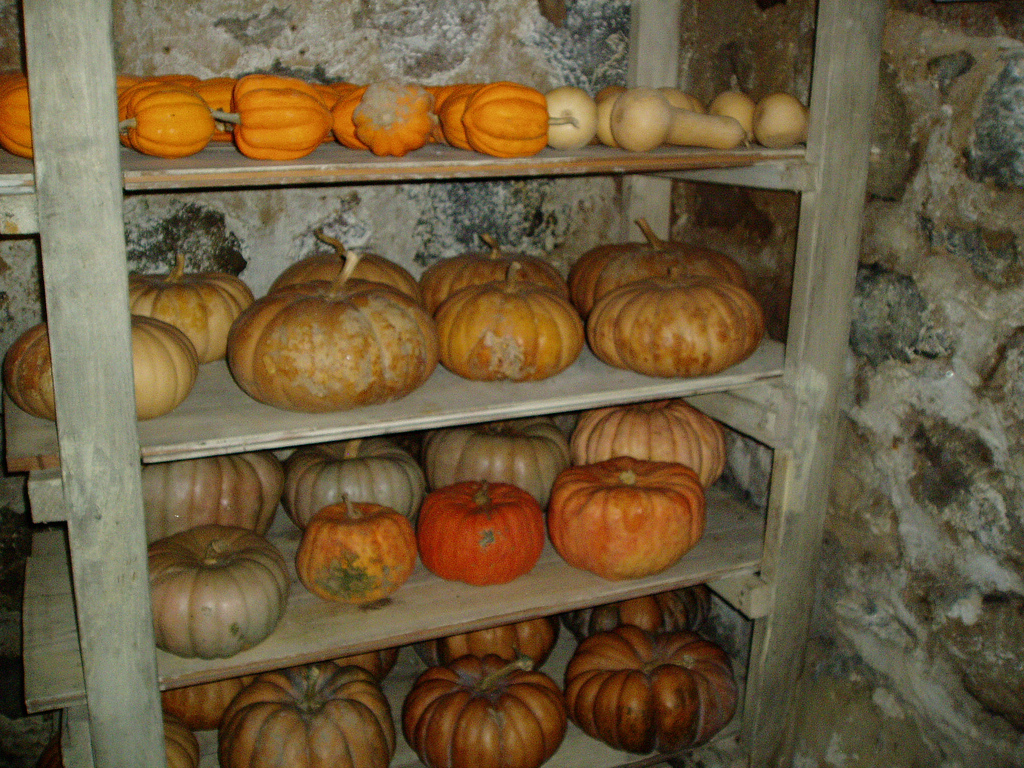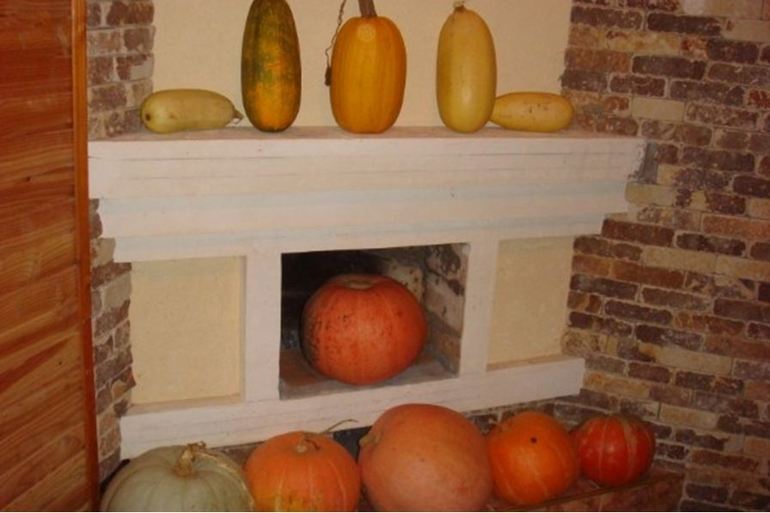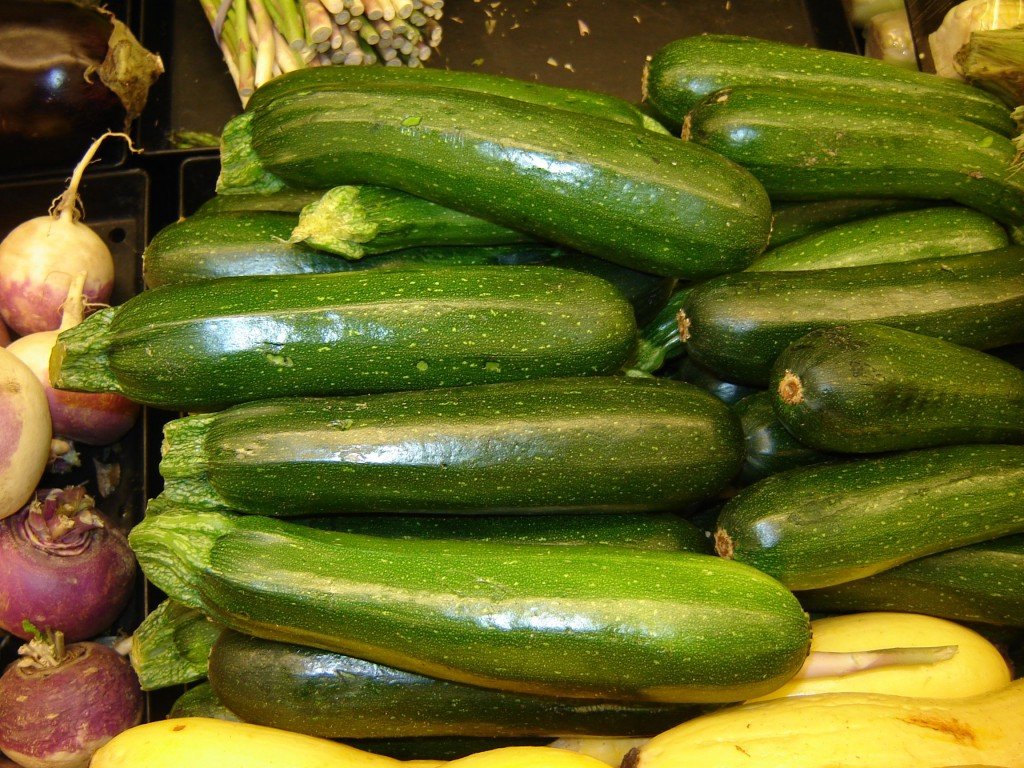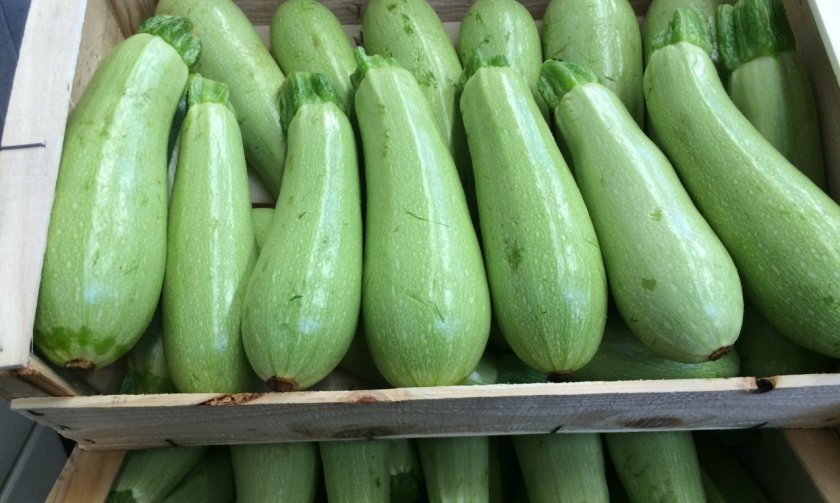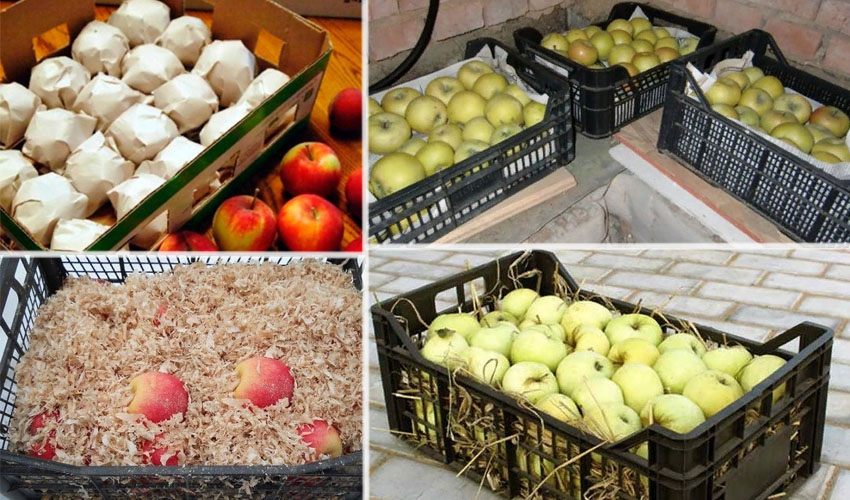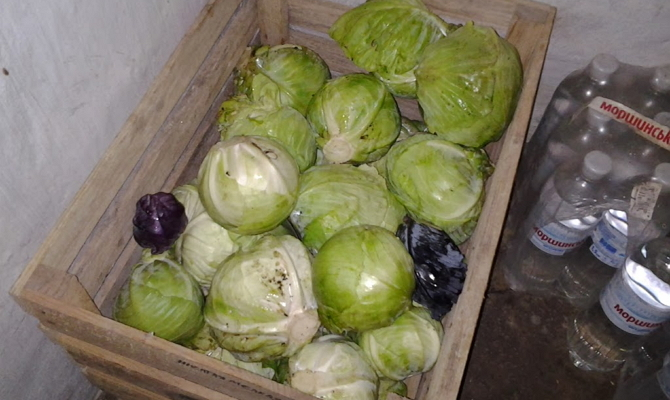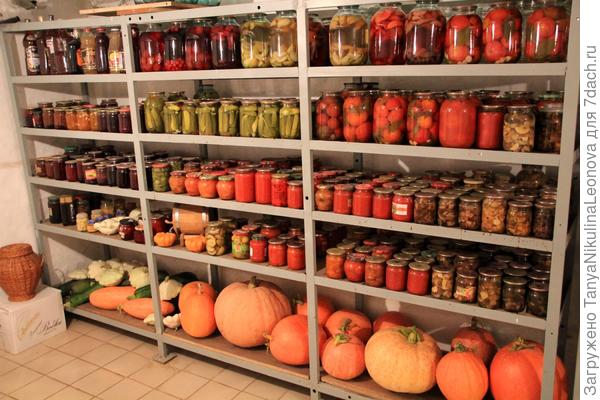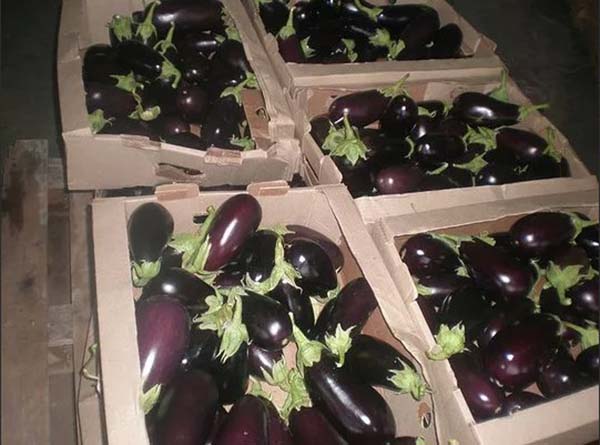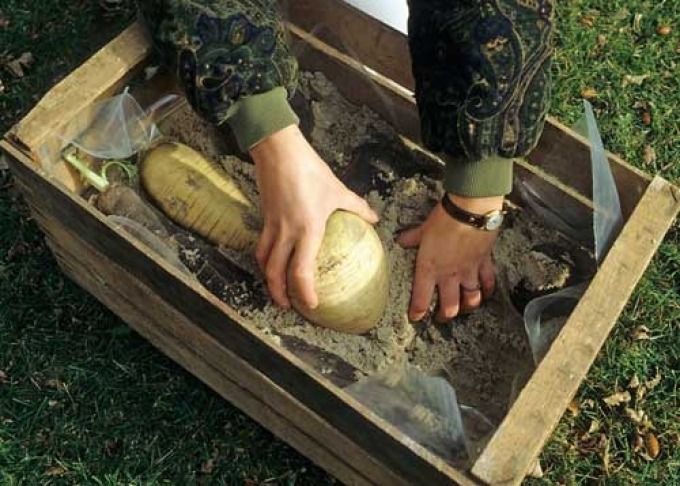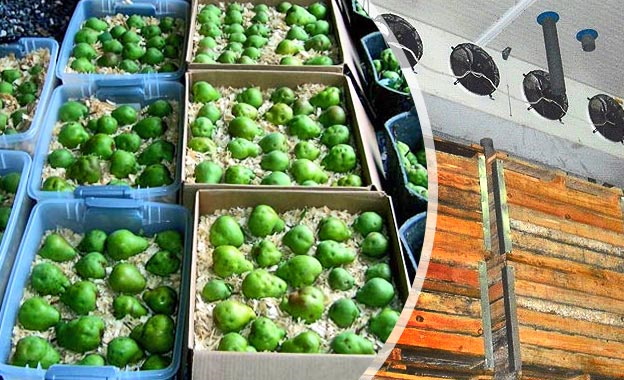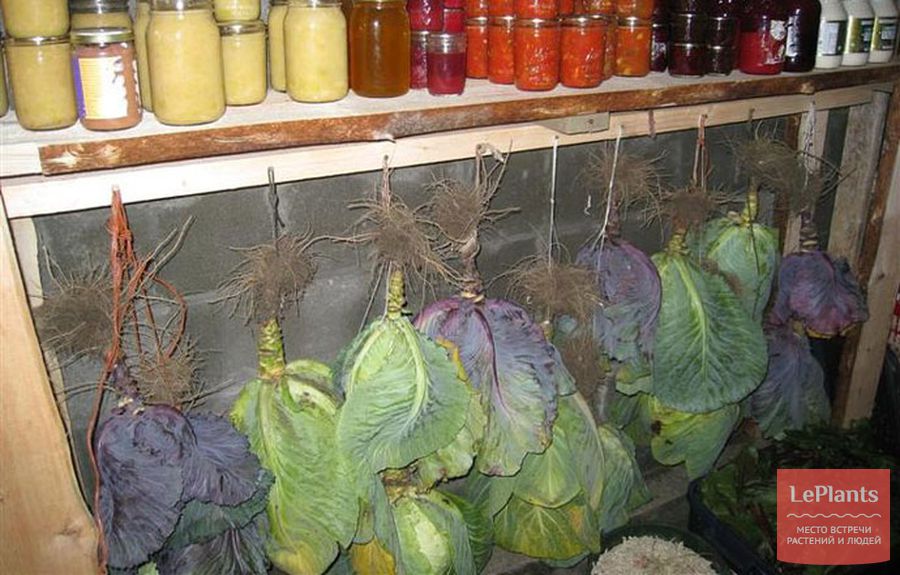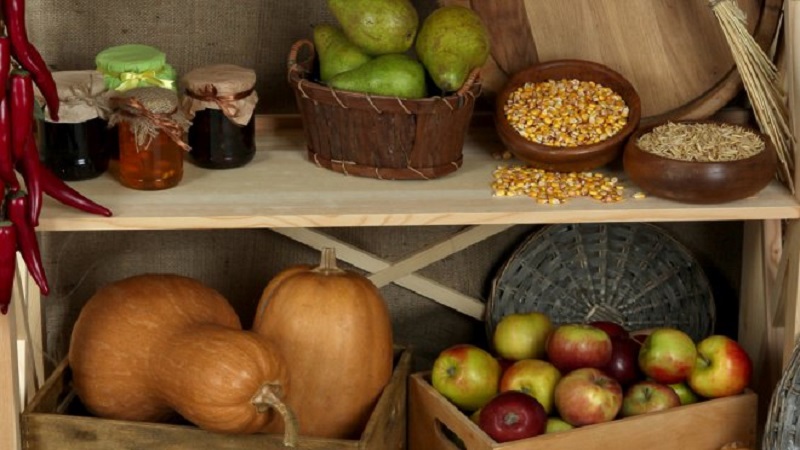Storage in the apartment
City dwellers for the most part, alas, are deprived of the opportunity to make large stocks of fresh vegetables for the winter due to the lack of suitable premises, but there are still ways that will tell you how to successfully store zucchini at home.
You need to choose a place in an apartment according to the following criteria:
- remoteness from heating devices;
- lack of light, especially sunlight;
- air circulation, but not drafts;
- moderate humidity.
Thus, zucchini can be placed under the bed or on the floor near the coldest wall found in all corner apartments. How long the zucchini will lie in such conditions, again, depends on the care with which they were treated.
You can extend the shelf life by wrapping each vegetable in paper, dividing them with partitions. Straw bedding is especially good for them. Of course, a weekly check-up is a prerequisite for the health of the entire party.
A well-maintained balcony is an excellent way out, many summer residents have long adapted their loggias for partial storage of crops, both fresh and canned.
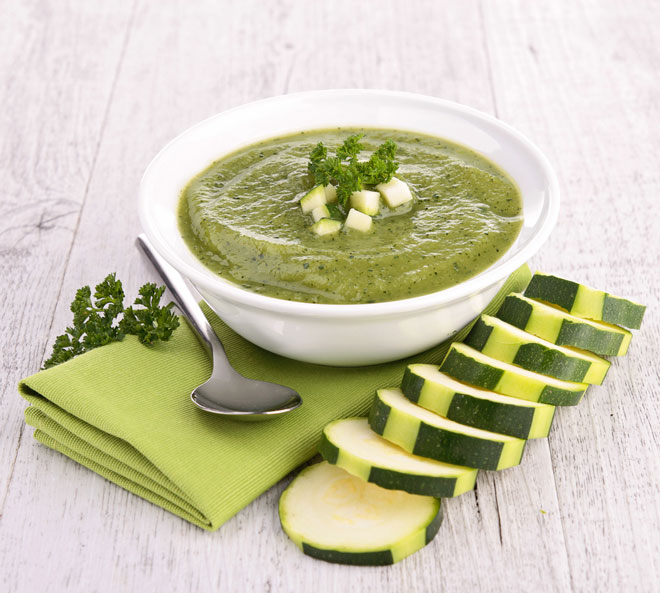 In winter, zucchini will serve as the basis for the first, second courses and side dishes.
In winter, zucchini will serve as the basis for the first, second courses and side dishes.
General rules for storing zucchini at home
Regardless of the chosen storage location, there are a number of general rules, the observance of which will not allow the zucchini to quickly deteriorate.
First of all, it is worth considering the following:
- Only clean and dry fruits can be put into storage, without any signs of decay processes.
- Wherever you place the zucchini, they should be kept open, with constant access to air (clogging in plastic bags is unacceptable).
- The optimal temperature indicators at the storage location are considered to be values within + 4 ... + 10 ° C, although the fruits can be stored at room temperature (+ 18 ... + 23 ° C).
- When placing vegetables (preferably on wooden pallets), make sure that they do not come into contact with each other or with other objects, which will prevent putrefactive processes in the places of such contacts.
- Rotting can also be avoided by treating the tail of the fruit with liquid paraffin or wax, because it is from this place that rot begins to spread throughout the vegetable.
-
With the arrival of spring, the fruits remaining in the storage are wiser to eat, having previously peeled and chopped on a grater.
Important! If one fruit has deteriorated, others will follow, so it is worthwhile to regularly inspect the crop and remove damaged or rotting specimens in a timely manner. It is better to transfer whole and dense fruits to a clean and dry surface, covered with dry sawdust.
Features of storage locations
Zucchini are popular not only for their tasty and healthy pulp, but also for their excellent keeping quality. You can keep the zucchini fresh for the winter both in a private house and in an apartment. Let's consider both options in more detail.
In the apartment
It is very important at what temperature you will store the zucchini in winter. Due to the fact that the vegetable is suitable for a temperature of +10, it can be stored in apartment conditions.
To normally keep zucchini for the winter in an apartment, you must follow the rules:
Storage is carried out in a dry, dark place: under the window, on the balcony, in the closet, in the refrigerator
It is important to keep the vegetable in the dark.
At room temperature, you can keep zucchini for the winter in an apartment for no more than 3-4 weeks. And at t 4-12 C, vegetables can lie for 2-4 months.
Vegetables should be kept separately
Therefore, storage in bags, bags is not suitable. If there is not enough space, but there are a lot of fruits, then you need to separate them with a partition.
Places in the apartment where you can store zucchini:
- Balcony or storage room.If the balcony is insulated and room temperature is maintained on it, then at this temperature it will be quite problematic to keep the zucchini for longer than a month and a half. If the balcony is cool, then the fruits will lie like in a cellar. Better to put vegetables in wooden boxes or on shelves lined with paper.
- Fridge. Although this is a rather limited space to store a lot of fruit, a couple of copies can be placed. You can store zucchini in the refrigerator for no more than 2 weeks, because the fruit will not lie due to the high humidity. The decay process may begin. It is better to fold the fruit in a paper bag with pre-made holes for ventilation.
Under the windows. If there is no balcony in the apartment, then you can store the zucchini in the apartment right under the windows, just not near the battery. It is convenient to put fruits in boxes. The main thing is to ensure that the container is darkened from light.
In a private house
As a rule, keeping zucchini fresh for the winter in a private house is not difficult. There is enough space for this.
Without a doubt, the best place to store zucchini for the winter is in the cellar (basement). But you can put the crop in an insulated barn or in another room in the house. The place where the zucchini will be stored must meet all sanitary requirements.
Consider the parameters of the cellar in which you can store zucchini for the winter:
- The room must be clean, dry and maintained at a certain t mode. There should be no mildew, mold, too high humidity. You also need to take care of cleaning the room from rodents and insects. After pickling the pests, a general cleaning should be done.
- The cellar or basement in which you will store zucchini for the winter should be well ventilated, and protection from groundwater should also be provided.
- Ideal t + 4 + 10 C.
Video: how to keep zucchini fresh for the winter at home.
When the cellar meets these requirements, you can move the zucchini there and store for the winter:
- It is most convenient to organize special racks or boxes.
- It is recommended to put sawdust and hay on them.
- The fruits should not be rubbed, it is also necessary to provide that moisture does not get under them.
If you store zucchini in a cellar in winter, taking into account the above rules, then you can save the vegetable until spring. However, with a change in t and the arrival of heat, the seeds in the zucchini begin to sprout, which spoils the vegetable. It is better to use it for its intended purpose until this time.
Video: how to store zucchini at home.
What to do if zucchini starts to deteriorate
The rules for storing zucchini for the winter at home do not guarantee that all the fruits will endure steadily for several months after harvest. Vegetables should be inspected every 1-2 weeks. If the fruit is spoiled, it must be immediately separated from the rest and thrown away, otherwise the rest will undergo rapid decay. This is the case with other vegetables, for example, with carrots in storage.
You can determine that the zucchini is spoiling by external signs:
It is not recommended to wait until mold or obvious signs of decay appear.
pro_zvetok
honeycake_natalia
urozhainyi_ogorod
gorody_net
If you follow all the instructions, fresh zucchini can be used almost all year round. Zucchini, which is stored in the basement, remains fresh for the longest time. They will live until spring. You can even keep a watermelon in the cellar for the New Year.
Not everyone has access to a personal cellar, so storage at room temperature at home is an alternative. Unlike the refrigerator, this way you can save not 2-3 zucchini, but much more. And the shelf life is 3 times longer.
Previous
Vegetables and fruits Secrets of how to keep melon before New Year at home
Next
Vegetables and fruits How to store boiled beets in the refrigerator
All ways to store zucchini
There are several ways to keep fresh zucchini. All of them are available to most summer residents, and can be implemented without special costs. The first and easiest storage is in the cellar with other vegetables.The second, more laborious one - in the apartment. A third method suitable for keeping a small amount of zucchini is in the refrigerator or freezer. Each of these methods has its own subtleties, advantages and disadvantages.
The general storage conditions for zucchini are as follows:
- Lack of light, especially sunlight. Under bright light, natural ripening processes occur in the fruit of a vegetable, in which the seeds inside it begin to germinate, consuming nutrients, including those contained in the pulp. As a result, the zucchini loses its elasticity, and its skin gradually becomes thinner.
- Stable temperature in the range from +2 to +10 degrees. At such a temperature, all intercellular processes in the pulp and skin of the zucchini are suspended, due to which it remains crispy, juicy and healthy.
- Constant moderate humidity. An increase in humidity, as well as a decrease in it, can negatively affect the state of the zucchini. The situation is even worse with constant fluctuations in the moisture level in the room where the fruits are located. They can rot or "lose weight" due to drying out.
- It is recommended to lay the zucchini in one layer so that they do not come into contact with each other.
It is not so easy to achieve compliance with these conditions, but with special diligence, it will become available to most lovers of fresh vegetables grown on their site.
In the apartment
From the very beginning, it is worth making a reservation that it is unlikely that it will be possible to keep zucchini in the apartment until spring, if only because the temperature in the living quarters is rarely maintained at a suitable temperature for this business. However, you can put them in the coolest part of the house - on an insulated balcony, in a closet or close to the balcony door. Cabinets or drawers located at floor level are also suitable for this (the air is always cooler there).
They need to be laid in one row, or even better - wrap each fruit in wrapping paper in order to exclude drops of moisture from getting on its skin (which often happens in everyday life).
Once every few days, you should carefully examine the zucchini for rot. It appears primarily on the stalk. First, there appear grayish specks (sometimes with black "dusting"), which then spread to the skin of the fruit. After that, they degenerate into watery-looking, but dry to the touch specks, which then soften. In order to prevent extensive rotting, it is recommended to immediately remove spoiled fruits from storage, cut off the rotten parts, and eat the normal part of the vegetable.
Despite the suitability of such zucchini for food, it is not recommended to make dishes from them for young children.
In the cellar
The cellar is the best place to store any fresh vegetables, including zucchini. In this case, it is highly desirable to use racks or shelves made of slats, on which vegetables will be well ventilated from all sides. Zucchini should be placed on them at some distance from each other and only in one layer.
It is also not recommended to store apples and other vegetables and fruits in the immediate vicinity of zucchini. Better if they are located on different shelves. Waxed paper will help keep them fresh longer, which will prevent other vegetables and fruits from affecting the zucchini.
In fridge
In a household refrigerator, zucchini can be stored for a long time, but this often does not happen, since the humidity in it is too high. To avoid quick spoilage, it is worth wrapping vegetables in tight paper bags, but even this will keep them fresh for no longer than three weeks.
The refrigerator is good for small squash with fragile skins, which are not suitable for storage in the basement.
If it is not possible to place zucchini in a cellar or at home, they can be placed in the freezer until spring. True, this method will require a lot of time and effort. First, the zucchini will need to be rinsed well and peeled.Secondly, they will need to be cut into small pieces or rings, and then put into bags. Only then can they be frozen.
Preparing the cellar and vegetables
It is necessary to take care of the preparation of the basement or cellar even in the summer. To protect the crop from mold, fungi and pathogens, the room should be well disinfected. The most affordable way to disinfect the cellar is to whitewash the walls with lime. To do this, 1 kg of slaked lime is mixed with two buckets of water. To the resulting solution, you can add 100 grams of copper or iron sulfate.
Another popular disinfection method is sulfur fumigation. This procedure drives pests out of the cellar. During fumigation, the doors of the underground storage are tightly closed and people are not advised to enter there for several days. At the end of the isolation period, all ventilation openings and doors of the cellar are opened for through ventilation. All shelves, stands and drawers in the cellar should be disinfected separately.
Important! In the middle of a hot day, it is better not to ventilate the cellar or basement, because the warm air entering the underground room leads to the formation of condensation on the walls and ceiling.
To do this, they are treated with a solution of copper or formalin sulfate, which can be purchased at garden centers, and then taken out into the street to dry in the sun. Some owners saturate the wooden shelves in the cellar with engine oil, which also prevents them from rotting and the formation of mold. Before storage, you need to pre-prepare the zucchini - this is a prerequisite for their long-term preservation.

Steps to prepare for winter storage are taken already during harvest:
It is necessary to remove vegetables from the garden before the first frost - if you harvest after the first freeze, they will rot during storage. If the zucchini are even slightly affected by frost, they cannot be stored.
For long-term preservation, only ripe fruits are suitable, whose skin has already hardened and hardened. Ripeness can be recognized by the characteristic dull sound that appears when you knock on the zucchini.
It is also important to carefully check each vegetable for integrity - only those with no scratches and dents on the skin are suitable for storage.
Fruits with damaged skins quickly deteriorate and threaten to rot all stored vegetables.
It is important to pay attention to the stem of the fruit. Vegetables growing on a thick and green stem are suitable for long-term storage.
Fruits on dried stems have already lost their juicy taste and will not last long.
Removing the zucchini from the parent's lash, a stalk is left on them, thanks to which the infection does not penetrate under the skin of the vegetable
Also, the stalk helps to ensure that the pulp of vegetables remains juicy for a long time. By the stalk, you can judge the safety of each vegetable, if it is dry - the zucchini is perfectly stored, if it rots - it must be immediately isolated from neighbors, it is best to take it out of the room and use it for cooking.
In no case should you wash zucchini intended for long-term storage - they are carefully cleaned of adhering soil and dried in the sun. Under the influence of ultraviolet rays, the skin is strengthened and further protects the pulp better. When separating the vegetable from the stem, it is best not to break it, but use a sharp knife.
Wherever the zucchini is stored in the future (cellar, pantry), they should not be wrapped in plastic bags - this will contribute to rotting.
Important! These vegetables are best stored in a cool, dry cellar or basement in a residential building. In the cellar, dried and peeled zucchini are placed so that there is a gap of five centimeters between them.
This is necessary so that one rotting zucchini does not infect all the others.
6 Storage in a cellar or basement
There is another way to store these vegetables - this is a cellar
It is important that the cellar complies with all standards for storing vegetables. Keep it cool, dry and dark, and free of any pests and mold
At temperatures up to ten degrees, vegetables can be stored for up to six months.
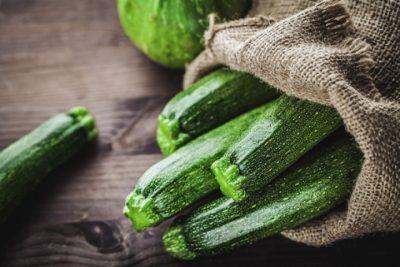
Zucchini should be placed on certain shelves prepared in advance, preferably wooden ones. Vegetables need to be laid out at some distance from each other, about 5-7 centimeters. You also need to make sure that the courgettes do not come into contact with the walls of the cellar, as moisture condensation can collect on them.
Dry hay can be used as a substrate under the fruit. But at the same time, periodically make sure that it does not get damp. If this happens, then you need to replace the hay with fresh and dry.
It is important with the onset of severe winters, if the temperature in the cellar or basement falls below normal (less than 4 degrees), then it would be best to cover the vegetables with rags
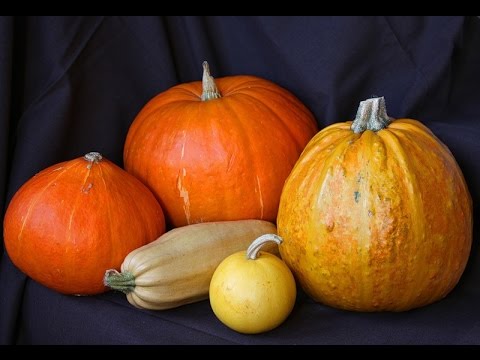
Another way to store vegetables in the cellar is in nets suspended from the ceiling. Each fruit should be placed in a small net and hung on hooks or nails nailed to the ceiling. Also make sure that there is no contact with each other.
With this storage, it is important to frequently ventilate the cellar. Old worn-out nylon tights can be used as a hanging net.
Zucchini varieties suitable for long-term storage
An important condition for long-term storage is the correct choice of the variety. For good keeping quality, you need a dense peel, a small amount of small seeds
The following varieties meet these conditions:
- Aral. Hybrid variety, early ripening in 35-40 days. The fruits weigh up to 0.8 kg. Very high yield - up to 22 kg per sq. m. Fruits are cylindrical, pale green in color, weak ribs. The length of the fruit is 15-20 cm, the pulp is dense and tender, the seeds are large.
- Arlika. Dutch variety, average ripening period - 50-65 days. Fruits grow up to 15-17 cm, weight 0.8 kg, light green peel with a dark mesh. The pulp is juicy, but loose. Brings up to 6 kg from 1 sq. m.
- Aeronaut. This is a courgette-zucchini, early ripening, takes 45 days. Fruits grow about 15-20 cm long, weighing up to 1.5 kg. A variety with a high yield - up to 7 kg per 1 sq. m. Fruits can be stored for 4 months.
- Gribovsky 37. An unpretentious hybrid, the average ripening period is 45-55 days. Light peel, fruits grow to 17 cm, average weight - 1 kg. The variety brings up to 9 kg per 1 sq. m.
- Pear-shaped. The name of the variety is associated with its shape - the fruits thicken towards the base. The peel is pale yellow, the weight of the fruit is up to 1.4 kg. Ripening in 50 days, yield - up to 9 kg per 1 sq. m. Juicy and fragrant orange pulp. The peel is very dense, the fruits are stored for a long time.
- Yellow-fruited. Domestic variety, early ripening - 45 days. Fruits of a sunny yellow color with a saffron net resemble bananas, grow up to 20 cm, the average weight is 1 kg. The variety brings up to 18 kg per 1 sq. m.
- Gold Cup. Hybrid bush variety, early ripening. One bush simultaneously bears 5-6 fruits 16-20 cm long and weighing 1 kg. The harvest is perfectly stored until February.
- Marquis. Hybrid variety, early ripening - 40-45 days. Fruits are dark green with white flesh, grow up to 45 cm, average weight - 3.5 kg. 1 sq. m can bring up to 11 kg. The variety is resistant to temperature extremes, excellent for transportation.
- Negro child. Hybrid variety, early ripening after 40 days. The fruit has a dark green color, small whitish dots are possible. The pulp is greenish-white in color, the average weight of the fruit is 1 kg. The harvest is large, up to 18 kg per 1 sq. m.
- Tristan. Hybrid zucchini-zucchini, ripening ultra early - 35 days. Fruits with a smooth dark green skin and delicate white content, length 25-30 cm, average weight - 1 kg. 1 sq. m planting brings up to 15 kg of zucchini.
- The festival. An unusual variety, the fruit with its rounded shape resembles a pumpkin.The colors alternate stripes of different colors: greenish, bright yellow, whitish, almost black. Fruits weigh 0.5 kg each, average yield - up to 6 kg per 1 sq. m. Excellent keeping quality - the harvest is well preserved for up to 10 months.
- Anchor. Hybrid variety, ripens in 40 days. Fruits are pale yellow in color, the flesh is the same, the average weight is 1 kg. The harvest is good, up to 12 kg per 1 sq. m.
Fruit selection
Before storing, you need to select the fruits correctly. If you have your own summer cottage, you should choose the right type of zucchini for planting.
Experienced summer residents are advised to put aside zucchini with white skin for storage (for example, the fruits of such varieties: "Belogor", "Beloplodnye", "Gribovsky 37" - the oldest and still one of the best, "Yakor", "Sosnovsky", "Rolik" ). By winter, their peel becomes thick, impenetrable (this happens with all pumpkin seeds), they are stored perfectly, no worse than zucchini.
At the same time, it is not the classic zucchini that is advised to be put into storage, but zucchini - it is widely believed that they retain their original qualities much better due to the structure of the fruit.
For long-term storage, it is better to choose zucchini or white-fruited zucchini.
If possible, it is better to lay the fruits for storage immediately after removal from the bush. First of all, put aside overripe specimens - they will not lie for long. Choose ripe, medium-sized vegetables. If you buy zucchini from the market and can't tell how ripe they are, do a little test: try piercing the skin with your fingernail. If it is very difficult or impossible to do this, then the fruit is suitable for storage.
Pay attention to the surface condition of the fruit. You can keep zucchini fresh for a long time only if there are no damages or flaws on them.
The slightest scratches on the skin will lead to rot, which will quickly spread to the entire batch of vegetables.
It is also important to select for storage zucchini with stalks.
Before sending vegetables for storage, it is recommended to carefully clean them from the ground and dry them a little in the sun (you cannot wash them). After this manipulation, the peel will become more firm, which will significantly extend the shelf life of the vegetable.
We select a convenient way
In the refrigerator, the zucchini is kept whole in the vegetable compartment. This storage method is also suitable for early varieties. Wrap each fruit in paper or a plastic bag. Pre-make holes in the package so that moisture does not accumulate and the zucchini does not start to rot.
In a cellar with a humidity of 80-85% and a temperature of +4 to +10 degrees, it is possible to keep the harvest until spring. To do this, check that there is no mold or rodents in the basement. Maintain optimal temperature and humidity. Ventilate if necessary.
Arrange the fruits so that they do not touch, on racks, shelves, in boxes. Hang from the ceiling of the cellar in stockings or nets.
Protect crops from the spread of disease and moisture:
- spread dry straw;
- make partitions of thick cardboard between the zucchini;
- wrap each fruit in wax paper.
There are several options for storing zucchini in an apartment:
- in boxes that can be placed under the bed, on a heated balcony, in a closet;
- spread in one layer on sawdust or straw under the bed.
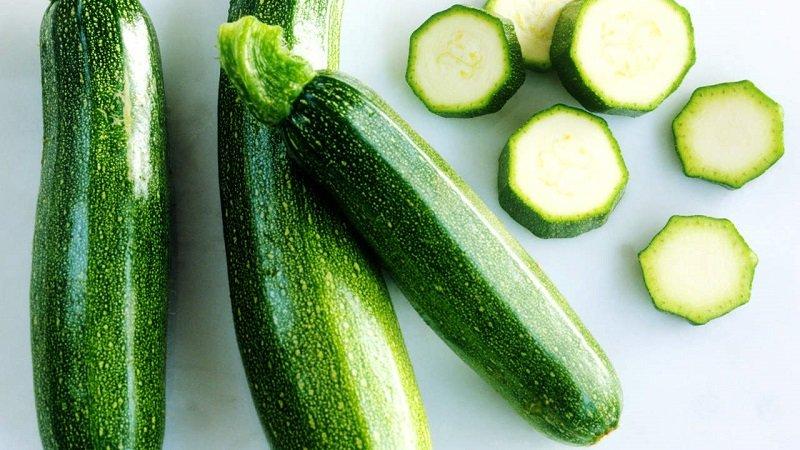
Find storage methods that are convenient for you. Check the condition of the fruit, especially the tail, every 10-14 days. Maintain the optimum temperature (+4 degrees) and humidity in the cellar or apartment. When performing these simple manipulations, you will save the harvest until spring.
In the refrigerator on a vegetable shelf, zucchini can withstand storage for 2-3 months. In the freezer, the shelf life of zucchini is increased to six months.
Alternative ways
Zucchini at home can be stored not only as a whole. There are other ways that we will now look at.
Drying is a simple, convenient, financially beneficial method in which the vitamin and taste qualities of the vegetable are not lost. All varieties of zucchini are suitable for her.
Choose young fruits that have not yet set seeds, or peel them off. Spread the washed, peeled, chopped vegetables at a distance of 5-10 mm from each other or string them on a strong thread.
Drying types:
- sunny-air - on a sieve in direct sunlight, on a string in a well-ventilated, warm room or outside for 3-4 days;
- in an oven preheated to 50 degrees - on a baking sheet for 6-7 hours;
- in an electric dryer at a temperature of 45-50 degrees - on a wire rack for 4-5 hours.
Zucchini are dried until the moisture has completely evaporated, while they lose up to 90% of their weight. The degree of readiness of zucchini is determined by their appearance after cooling. The pieces darken, wrinkle, become elastic.
The resulting dried product is stored closed in glass, plastic jars or bags, in a dark place.
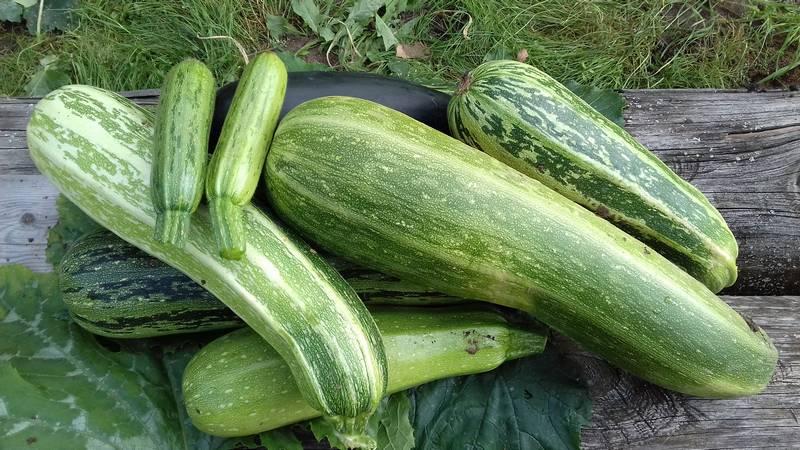
Before adding to dishes, dried zucchini can be soaked in warm water for 20-30 minutes so that they return to their original shape. But this is not necessary, because during stewing and cooking, this will happen without your participation. Porridge, vegetable stew, soup, vegetable casserole, scrambled eggs - an incomplete list of dishes that you can cook with this product.
Freezing is a modern, convenient way to store vegetables and fruits. Consider how to properly freeze zucchini.
There are several options:
- Rings.
- In pieces (cubes, sticks).
- Chopped on a grater.
- In the form of mashed potatoes.
Whichever method you choose, wash and dry the vegetables thoroughly.
Spread zucchini, cut into rings, in one layer on a cutting board, flat plate or tray, put in the freezer for 2-3 hours. After that, put the frozen pieces in bags or containers and put them in the freezer for storage. They are added to a vegetable casserole, an omelet, fried in a pan with garlic and dill.
Freeze cubes and sticks, grated zucchini immediately in containers or bags. The pieces will make the perfect semi-finished product for vegetable stews, soups, cereals. After defrosting grated vegetables, you can bake pancakes and pancakes.
Freeze squash puree for feeding the baby in plastic jars or molds. For ease of use, try to choose small forms (1 time).
Preservation is a laborious, but excellent method in terms of results and shelf life. After heat treatment, workpieces are stored in sterile jars from one to three years. Zucchini do not have a distinct taste of their own. Preservation with salt, vinegar, spices helps to acquire it.
For this method of harvesting vegetables for the winter, both early and late varieties are suitable. Fresh fruits are taken for processing without traces of rotting and mold. In jars for the winter from zucchini, you can close salads, caviar, lecho, salted or pickled zucchini rings or slices of zucchini.
Is it possible to freeze zucchini for the winter
It is no surprise to anyone these days that fresh vegetables, fruits and berries can be frozen in refrigerators. For these purposes, zealous, thrifty owners purchase special freezers in order to provide seven vitamins throughout the winter.
In the refrigerator compartment, zucchini can be stored for up to 3 weeks in the fruit and vegetable compartments. This product will lie in the freezer for a year and nothing will happen to it, you just need to properly freeze it using the following technology:
- Wash the zucchini and cut off all the skins, remove the seeds and rinse again.
- Dry the vegetable lightly with a napkin, cut into slices (in a circle or semicircle) 3 centimeters thick.
- Place the pieces in a colander and immerse in boiling water for 3 minutes, at this time prepare a container with ice water, immediately transfer the colander from boiling water to ice. Hold in cold water until it cools completely, and let the water drain.Arrange the pieces in a single layer on a baking sheet or other suitable tray and place in the freezer. After the zucchini is completely frozen, you can put them in any container and store in the freezer for a long time.
Zucchini frozen in this way can subsequently be thawed and used for any dishes; they will not lose their taste and health-promoting elements.
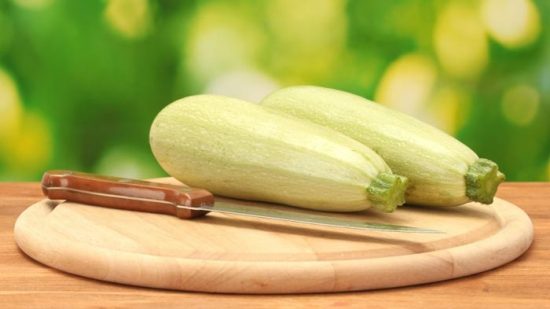 Store zucchini in a cool, dry place.
Store zucchini in a cool, dry place.
Conclusion
Zucchini is a healthy, tasty vegetable. Salads, caviar, adjika prepared in jars will serve as a decoration for your table throughout the winter. In this article, we have offered you other options for storing crops in the winter at home. Choose the one that suits you best.
But remember that during freezing, drying, storage as a whole, the vitamin and mineral composition remains unchanged, and during heat treatment, some of the useful properties are lost. Do not overexpose unprocessed vegetables in storage. Use the summer harvest actively before it loses its appearance and useful qualities.

